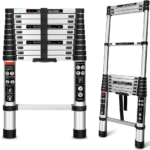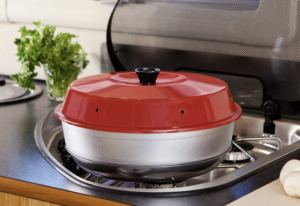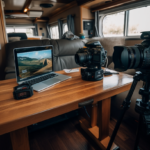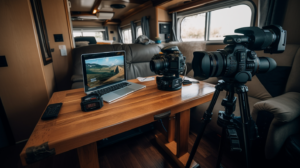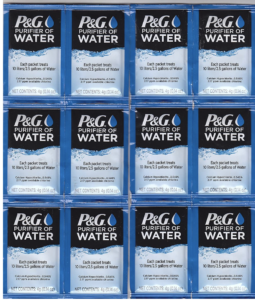
Augtarlion Aluminum Telescoping Ladder Review
Hello there! Today, I’ll be reviewing the Augtarlion Aluminum Telescoping Ladder, a versatile piece of equipment that has become an integral part of my toolkit. Let’s dive into the details!
Introduction and Key Features
The Augtarlion Aluminum Telescoping Ladder is a 10.5 feet collapsible extension ladder equipped with a locking mechanism. It’s ideal for home use or outdoor work and has a heavy-duty weight capacity of 330lbs. Crafted from premium 6061 thick aluminum alloy, the ladder is incredibly durable and can withstand the test of time. With a compact size and adjustable height, this ladder proves to be very practical, especially for those hard-to-reach areas.
Design and Quality
The quality of the Augtarlion ladder is evident right from the start. The aluminum alloy material is not only sturdy but also resistant to rust and corrosion, prolonging the lifespan of the ladder. Each step falls slowly and smoothly when retracting, preventing any hand-pinching accidents. The nylon fiber-reinforced plastic parts further enhance the ladder’s load capacity.
The design of this ladder is quite thoughtful. It can compact from 2.6Ft to 10.5Ft, and when not in use, it can be folded to save space. There’s an integrated carrying handle and a heavy-duty velcro storage strap, making transportation and storage a breeze.
In-Depth Analysis
What sets this ladder apart is its intelligent locking mechanism, which ensures safety at every step. This feature is handy, especially when you’re working alone. The adjustable height is another standout feature – whether you’re painting a high wall or reaching the top shelf in a cabinet, this ladder can adjust to your needs.
One important aspect to note is the ladder’s multi-purpose use. It’s a fantastic tool for household chores, professional work, window washing, interior or exterior decorating, roof repairs, and even tree climbing. The possibilities are endless!
Comparison with Similar Products
When comparing the Augtarlion ladder with similar products, it’s clear to see that this ladder’s design, safety features, and durability put it a notch above the rest. While other ladders may boast similar functionalities, they often fall short when it comes to build quality and stability. The Augtarlion ladder, with its robust build and thoughtful design, definitely stands out.
Pros and Cons
Pros:
- Durable and sturdy aluminum alloy material
- Intelligent locking mechanism for safety
- Compact design for easy storage and transportation
- Versatile use
- Excellent load capacity
Cons:
- The retracting process may take some time to get used to
- Rubber feet might crack over time
User Experiences and Testimonials
Most users praise the Augtarlion ladder for its easy maneuverability, particularly for women, as one reviewer pointed out. Many love how compact it is, making storage simple, and appreciate its sturdy and reliable construction. Some users even received two ladders for the price of one, which was a welcome surprise! However, a few users experienced cracking in the rubber feet and wished the ladder had a soft-close feature. Despite this, the majority of users were happy with their purchase and found it to be a valuable addition to their toolkit.
Tips and Tricks
To maximize the lifespan and usability of your Augtarlion ladder, remember to retract it slowly to avoid pinching your hands. Always ensure that the locking indicators at each step are showing a secure status before climbing. When storing, it’s best to keep the ladder in a dry and shaded place to prevent damage from weather elements.
FAQs
Q: How much does the ladder weigh? A: The ladder weighs approximately 25 pounds
Q: Can this ladder retract upwards, for example, if used for a pull-down attic access? A: While this concept sounds neat, it isn’t practically applicable. Each rung of the ladder has locking tabs that need to be pressed to retract it. Unless you can reach the upper lock-tabs to release them, you can’t retract the ladder.
Q: Where is the ladder made? A: The ladder is made in China.
Q: How thick is the ladder when collapsed? A: The ladder is about 2 to 3 inches thick when fully collapsed.
Q: Does this ladder come with a carrying case? A: No, it doesn’t come with a carrying case. However, it comes with a closure strap and anti-skid handle for easy carrying and storage.
Q: What’s the maximum weight the ladder can support? A: The ladder can support a maximum weight of 330lbs.
Q: How can the ladder be shortened without collapsing it entirely? A: To shorten the ladder, press both release buttons and start bringing the ladder down. When you reach the desired height, grab the bottom of the rung in the center to stop it. Give it a slight push upward, and you will hear and feel it locking into place.
Conclusion
In conclusion, the Augtarlion Aluminum Telescoping Ladder is a solid, well-built, and versatile tool perfect for both professional and personal use. Its thoughtful design, sturdy construction, and impressive safety features make it stand out from the competition. Despite minor drawbacks such as potential wear on the rubber feet, this ladder is a great investment. Whether you’re a DIY enthusiast, a professional contractor, or simply someone looking for a reliable ladder for household tasks, the Augtarlion ladder could be just what you need! This ladder can be found here at Amazon.
Overcoming Challenges of RV Living: Practicalities of the Full-Time RV Life
Howdy! Living in an RV full-time, while brimming with adventure, comes with its fair share of challenges. Think of it as a charming, constantly moving jigsaw puzzle. Let’s explore some potential road bumps you might encounter in your RV life and share practical tips to navigate them smoothly.
Lack of Personal Space
Embracing the RV lifestyle often means trading sprawling space for the freedom of the open road. But let’s face it, even the largest RV can feel a bit tight, especially when you’re just starting out on this journey. The lack of personal space is one of the prominent challenges of RV living. Every inch matters, and there are days when you might wish for a little more elbow room or a bit more privacy.
However, the key to comfortable RV living lies in how well you utilize the available space. Smart storage solutions are your best friends here. Opt for furniture that doubles up as storage or can be folded away when not in use. For example, a bed with storage compartments underneath or a table that folds back into the wall can help maximize the living space.
Furthermore, keeping your living area organized is crucial. The more clutter-free your RV, the more spacious it will feel. A place for everything and everything in its place is a good mantra to follow. Invest in organizers, use the vertical space efficiently with wall-mounted holders, and regularly declutter to keep only the essentials.
Creating separate zones in your RV can also help make the space feel larger and cater to your need for personal space. Even if the boundaries are symbolic, designating specific areas for sleeping, dining, or working can provide a sense of order and personal space.
Lastly, remember to make the most of the outdoors. One of the biggest benefits of RV living is that your backyard can be a beach, a forest, or a mountain range. When the weather is good, take activities like dining or reading outside. This can help alleviate feelings of being confined and remind you why the call of the open road is worth answering.
Living in an RV may test your adaptability, but with a little creativity and a lot of patience, you’ll find ways to make your RV a cozy, comfortable home on wheels.
Managing Utilities
In the comfort of a traditional home, it’s easy to take utilities for granted. Turn on a faucet, and there’s water. Flip a switch, and you have light. But in an RV, managing utilities is a hands-on affair and definitely a crucial aspect of road living. Here, you’ll be dealing with your own power, water, and waste systems, and it can sometimes feel like a balancing act.
When it comes to power, most RVs are equipped with a battery system, and depending on your usage, you might find yourself running low quite frequently. The solution? Be mindful of your energy consumption. Turn off lights and appliances when not in use. Consider investing in energy-efficient appliances or even look into solar panels for a sustainable source of energy. If you’re frequently at RV parks or campgrounds, utilizing their electricity can be an option, but having a plan for off-grid living is crucial.
Water is another precious resource in RV life. You’re usually working with a limited supply, stored in your freshwater tank. Conserving water can become second nature after a while. Simple changes like taking short showers, turning off the tap while brushing your teeth, and using biodegradable, water-saving soaps can make a huge difference.
Finally, let’s talk about waste. Your RV has a gray water tank for used water from sinks and showers, and a black water tank for toilet waste. These tanks need to be emptied regularly, and this is one chore that is essential to master. Many campgrounds offer dump stations for this purpose. Make sure to use proper RV-friendly toilet chemicals and tissue to prevent clogging and odor issues.
Overall, managing your RV utilities requires a keen awareness of your consumption and the ability to adapt to more conservative usage practices. It’s all part of the adventure, and it offers an excellent opportunity to understand and reduce our impact on the environment. Remember, it’s all about adaptability and conservation when it comes to RV living.
Limited Access to Healthcare
One challenge that often surfaces when living the RV lifestyle is ensuring consistent access to healthcare. Unlike a stationary life where your trusted doctor is just a call away, life on the road often means new locations and unfamiliar medical facilities. However, don’t let this deter you. With the right planning and adaptability, it’s entirely possible to maintain good health and handle emergencies effectively while traveling.
The first step towards managing healthcare on the road is a preventative one – maintaining a healthy lifestyle. Regular exercise, a balanced diet, and getting enough rest can do wonders for your overall health. Regular health checks before setting off on long travels also help identify any potential issues early on.
When it comes to prescription medications, planning is essential. Ensure that you have an ample supply before you embark on your journey. Speak with your doctor about your travel plans, they can often provide extended prescriptions. Mail-order pharmacies are also a great resource, as they can ship your medications to your current location or a nearby pharmacy.
Emergencies can happen, and they’re even more stressful when you’re far from home. It’s beneficial to learn basic first aid and CPR techniques, and always keep a well-stocked first aid kit in your RV. Research the locations of hospitals and urgent care facilities in the areas you’ll be traveling through and keep this information handy.
Telemedicine has become a boon for nomadic life. Many healthcare providers now offer virtual visits, allowing you to consult with a healthcare professional over a video call. This convenience can be an excellent option for minor ailments and concerns.
Investing in a good health insurance plan that covers you across state lines is another crucial aspect. Some travelers even consider medical evacuation insurance, which covers the cost of transporting you to a hospital in case of a serious illness or injury.
Remember, ensuring access to healthcare while living on the road is more about anticipation and preparation. Stay proactive about your health, know your options, and you’ll find the open road can be just as accommodating to your healthcare needs as a stationary home.
Internet Connectivity
In the digital age we live in, having a reliable internet connection is no longer a luxury; it’s a necessity. This reality becomes particularly crucial when living the RV lifestyle. Whether you’re working from the road, staying connected with loved ones, streaming entertainment, or simply mapping out your next destination, a steady internet connection is vital.
However, maintaining consistent internet connectivity in an RV can come with its own unique set of challenges. As you travel through various regions, you may encounter areas with weak or non-existent cell service, making your regular mobile data connection unreliable. Campground Wi-Fi, where available, often struggles with slow speeds due to high usage or outdated infrastructure.
Despite these challenges, there are several ways to ensure you stay connected on the road. One of the most reliable solutions is to invest in a portable Wi-Fi device or a mobile hotspot. These handy devices create a personal Wi-Fi network by using mobile data, providing a stronger and more stable connection than your smartphone might.
If you’re frequently in areas with weak cell service, consider a cellular signal booster. These devices amplify the existing cell signal, improving your mobile data connection. There are many models available, some designed specifically for RV use.
Another option to consider is satellite internet. While traditionally more expensive and slower than other internet options, recent advances have made satellite internet faster and more affordable. It can be an excellent option for those who venture off the beaten path into more remote areas.
Also, don’t forget about public Wi-Fi. Many libraries, coffee shops, and even some large retail stores offer free Wi-Fi. While public Wi-Fi should not be your primary internet solution due to security concerns, it can provide a temporary connection when needed.
The key to staying connected on the road is flexibility and redundancy. Having multiple internet options at your disposal will ensure that you can get online when you need to. With the right setup, the internet can be just as accessible on the road as it is in a traditional home. So, get connected and share your adventures with the world!
Vehicle Breakdowns and Maintenance
An RV is more than just a vehicle; it’s your home on wheels. The last thing you want while exploring the open road is to be sidetracked by mechanical issues or worse, a breakdown. This can be a significant concern, especially if you’re in a remote area or unfamiliar territory. It’s not just inconvenient, it can also put a dent in your travel budget, and disrupt your travel plans significantly.
The key to avoiding such frustrating situations is preventive maintenance. Regularly checking your RV’s crucial systems, such as the engine, brakes, tires, and electrical systems, can help you catch small problems before they become major issues. This includes routine oil changes, checking tire pressure, and ensuring your brakes are functioning properly. Remember, an ounce of prevention is worth a pound of cure!
But, despite the best preventative measures, it’s important to accept that breakdowns can and do happen, often when you least expect them. Therefore, having a plan in case of a breakdown is essential. This might include having a roadside assistance plan that covers RV towing, which is often different and more expensive than standard car towing.
You should also have a basic understanding of your RV’s mechanical systems to troubleshoot minor issues on your own. There are numerous resources available, both online and in print, to increase your mechanical knowledge. You might also consider carrying a selection of tools and spare parts, such as fuses, light bulbs, and fan belts, that might be needed for small repairs.
Additionally, know where to find professional help when you need it. There are apps and websites that can help you locate the nearest RV repair center, and it’s a good idea to have these on hand before you need them.
Experiencing a breakdown can be a challenging aspect of RV living, but with preventive maintenance and a well-prepared plan, you can navigate these obstacles and continue enjoying your adventures on the road. After all, overcoming challenges is part of the journey and the stories you’ll tell later!
Weather Considerations
Weather plays a significant role in the RV lifestyle. It’s not just about the destination; it’s also about the journey, and the weather can greatly impact both. Sunny days make for lovely drives and outdoor activities, while a rainstorm might have you cozying up inside with a good book. However, severe weather conditions like snowstorms, heatwaves, or high winds can pose serious challenges to RV living.
Planning is crucial when it comes to weather. Before setting off on any trip, make sure to check the forecast for your route and your destination. Thanks to modern technology, there are numerous apps and websites that provide accurate and timely weather updates and alerts. Having this information can help you avoid dangerous weather conditions and plan your travels accordingly.
Despite careful planning, you may still find yourself caught in less-than-ideal weather. In these instances, understanding how to adapt to various weather conditions is essential. For instance, in high heat, make sure your RV’s air conditioning is functioning properly, and consider investing in window coverings to keep the sun out. In cold weather, properly insulate your RV, ensure your heating system is up to the task, and protect your water system from freezing.
Driving in adverse weather conditions, like heavy rain, snow, or high winds, requires extra caution. It’s essential to know your limits and the limits of your RV. If the weather is making driving unsafe, don’t hesitate to pull over and wait it out. Remember, safety should always be your top priority.
Additionally, remember that weather conditions can affect your RV’s maintenance needs. For instance, harsh sun can cause damage to your RV’s exterior, while cold temperatures can affect your battery performance. Make sure you’re aware of these effects and take the necessary steps to protect your vehicle.
Weather considerations might seem like a lot to manage, but with careful planning and preparedness, you can comfortably live the RV life in nearly any weather conditions. After all, some of the best memories can come from waking up to a fresh snowfall, watching a thunderstorm from the safety of your RV, or enjoying a breezy summer evening by the campfire.
Narrow Parking and Maneuvering Options
Parking and maneuvering a sizable vehicle like an RV can be a significant challenge, especially for beginners. Unlike a typical car, RVs require larger spaces, have wider turning radii, and may not fit in standard parking lots or driveways. This means you’ll often need to find specialized parking spaces, and in some cases, you might need to park some distance away from your actual destination. Plus, reversing and navigating through narrow roads or busy campgrounds can be a nerve-wracking experience.
The first thing to remember is that practice makes perfect. Spend time getting to know your RV’s dimensions and handling characteristics. Practice driving, parking, and reversing in a large, empty parking lot before hitting the road. Over time, you’ll become more comfortable and confident in maneuvering your RV.
Patience is also key. Never rush parking or maneuvering. Take your time, even if it means you’re holding up traffic for a little while. It’s better to go slow and park safely than to rush and potentially damage your RV or another vehicle.
Planning ahead is crucial when it comes to parking. Research your route and destination in advance to make sure they are RV-friendly. There are numerous resources available, including apps and websites that list RV-friendly parking spots and campgrounds. These resources often include reviews from other RVers, which can provide invaluable insight and tips.
In many urban areas, parking can be particularly tricky. If you’re planning to visit a city, consider finding a campground on the outskirts and using public transportation or a smaller vehicle to go into the city.
Lastly, investing in tools such as a backup camera and parking sensors can make a significant difference in easing the parking and maneuvering process. These devices give you a better view of what’s behind you and alert you to any obstacles, reducing the risk of any accidental bumps or scrapes.
While parking and maneuvering an RV can initially seem daunting, with practice, planning, and the right tools, you’ll soon master the art of navigating your home on wheels.
Lack of Privacy
One aspect of RV life that can be a bit of a surprise, especially for newcomers, is the potential lack of privacy. In the confines of an RV, personal space can be limited, particularly if you’re traveling with a family or group. This can make it challenging to find alone time or a quiet moment to yourself. Furthermore, when you’re parked in a campground or RV park, you’re often sharing a fairly small space with other travelers. It’s not uncommon for RVs to be parked close together, with only a small buffer of space in between. This proximity means you’re likely to see, and possibly hear, your neighbors quite regularly.
Creating a sense of privacy in such close quarters requires a bit of creativity and adaptability. Inside your RV, consider designating certain areas as private spaces where members of your group can retreat for some quiet time. This could be as simple as a curtain hung around a bunk or a specific seat designated as a quiet zone during certain times of the day. Noise-canceling headphones can also be a boon when you want to tune out the rest of the world.
Outdoors, consider setting up a privacy screen or using your awning to create a private area. Small folding screens or outdoor curtains can provide a visual barrier between you and your neighbors. Just be sure to respect campground rules regarding structures and enclosures.
Another key aspect of privacy is the mutual respect between you and your neighbors. Keep noise levels reasonable, especially early in the morning or late at night. If you’re camping with pets or children, ensure they respect the space of others as well.
Online, you might want to be cautious about how much detail you share regarding your location and travel plans, for both privacy and security reasons. It’s fine to share your experiences and photos, but consider doing so after you’ve left a location, especially if you’re traveling alone or in less crowded areas.
With a bit of planning and consideration, you can maintain a level of privacy that makes your RV feel like a sanctuary, even when you’re parked in a bustling campground. The RV lifestyle is a community, but that doesn’t mean you can’t enjoy your own private corner of it.
Maintaining Relationships
One of the biggest challenges when living on the road full-time is maintaining relationships with friends and family. It’s not always easy to keep in touch when you’re constantly on the move, and time differences can also add an extra layer of complication. Plus, there’s the fact that you’re not physically there for birthdays, holidays, and other special events. It’s a common misconception that living on the road can lead to isolation, but with some effort and flexibility, you can maintain and even strengthen your relationships.
Firstly, modern technology is a boon for keeping in touch. From video calls to instant messaging, social media to emails, there are countless ways to stay connected. Regularly scheduling calls or video chats with loved ones can provide a sense of stability and connection. Apps like Skype, Zoom, or FaceTime make it possible to see each other’s faces, which can help to make conversations more personal.
Secondly, remember that old-school communication methods still hold their charm. Postcards, letters, and care packages can be a fun way to share your adventures and let people know you’re thinking of them. Plus, who doesn’t love receiving snail mail?
Thirdly, plan for visits. Just because you’re on the road doesn’t mean you can’t spend quality time with your loved ones. You can arrange to meet up with friends and family at various points along your journey. Invite them to join you on the road for a week or two, or plan your route to pass by their homes. This gives you something to look forward to and allows you to create shared memories.
Lastly, make an effort to form new relationships on the road. The RV community is known for its friendliness and camaraderie. Join local groups, attend RV rallies, or get involved in online RV communities. These interactions can lead to lasting friendships with people who truly understand your lifestyle.
Remember, maintaining relationships while living on the road requires effort, but the rewards are well worth it. No matter where your travels take you, staying connected with loved ones can provide a sense of home and community that is incredibly enriching.
Got any tips or stories of your own? Or perhaps some questions? Feel free to share in
Campfire Pizza
 Ingredients:
Ingredients:
- 1 small pizza dough (about 8 oz or half a pound)
- 1/2 cup pizza sauce
- 1 to 1.5 cups shredded mozzarella cheese
- Your favorite pizza toppings, as needed (sliced pepperoni, bell peppers, onions, olives, mushrooms, etc.)
Instructions:
- On a clean and lightly floured surface, roll out the pizza dough into a round shape, about 1/4 inch thick.
- Lay the rolled out dough onto a campfire-safe pan or a piece of heavy-duty aluminum foil.
- Spread the pizza sauce evenly onto the dough, leaving a small edge for the crust.
- Sprinkle the shredded mozzarella cheese over the sauce.
- Add your chosen toppings. Be careful not to overload the pizza, as it may take longer to cook.
- Place the pan or foil on a grill rack over the campfire, but not directly on the flames. Cover with another pan or foil to create a makeshift oven.
- Cook for about 15-20 minutes, checking frequently, until the crust is golden and the cheese is melted and slightly bubbly.
- Remove the pizza carefully from the fire, let it cool for a few minutes, then slice and serve.
Remember, campfire cooking times can vary depending on the heat of your fire and the distance of the food from the flames, so always keep a close eye on your pizza to avoid burning.
Essential Safety Tips for New RV Owners
Hey there, fellow adventurers! Embracing the RV lifestyle is a thrilling decision, and for many of us, it’s the ultimate freedom. But let’s not forget that new RV owners have a unique set of safety considerations to be aware of before hitting the road. So buckle up, and let’s dive into the world of RV safety.
Understanding Your RV
Before we can talk about safety, it’s crucial to get familiar with your RV. Know your RV’s dimensions and weight like the back of your hand – this will be key when navigating underpasses, parking spots, and bridges. Don’t forget to keep a keen eye on your RV systems too. Regular maintenance checks before every trip will go a long way in ensuring your safety and that of your fellow travelers.
Driving Safety
Now that you’ve got to know your RV, let’s talk about driving. RV driving isn’t like driving your typical car. Remember, size matters! Adjust your speed, braking, and turning to account for your RV’s larger size and weight. It’s always better to take it slow and stay safe than to rush and risk an accident.
Load Safety
Speaking of weight, understanding your RV’s weight limits and distribution is essential for safe travel. Overloading can lead to dangerous situations, such as tire blowouts or poor handling. Remember to stow all items securely to prevent them from moving around while you’re on the road. Safety first!
Fire Safety in an RV
We don’t like to think about it, but fire is a potential risk in RVs. Regularly check your smoke alarms and keep a fire extinguisher on hand. Practice safe cooking and heating habits – never leave cooking unattended, and make sure all heating elements are off before you hit the hay.
Carbon Monoxide Awareness
Just like fire, carbon monoxide (CO) can be a silent threat in an RV. Make sure your RV is equipped with a working CO detector and use generators safely and responsibly. Remember, CO is a silent killer – stay safe by staying aware.
Safety at the Campground
When you reach your destination, your safety practices shouldn’t take a backseat. Choose reputable campgrounds, secure your RV, and be a respectful and safe neighbor to your fellow campers.
Traveling with Kids and Pets
Taking the little ones or furry friends along? You’ll need to make some additional safety considerations. Secure any loose items, protect all windows, and keep medicines and hazardous substances out of reach.
Emergency Preparedness
Hope for the best, prepare for the worst – it’s a good motto for any RVer. Have an emergency plan in place, and keep a well-stocked first aid kit handy. Stay calm and composed in case of emergencies, and know when it’s time to call for professional help.
Maintaining Your RV
Regular maintenance is key to long-term RV safety. Perform routine checks on all systems, including the engine, brakes, tires, and more. Remember, if you’re unsure about something, don’t hesitate to seek professional help. Safe is better than sorry!
Conclusion
Phew, that was a lot, wasn’t it? But don’t worry – while it seems overwhelming at first, safety will soon become second nature to you, new RV owners. The world of RV travel is one filled with joy and excitement, and taking safety seriously ensures you can enjoy the ride without unnecessary worries.
So now, over to you! Got a safety tip you’d like to share or a question about RV safety you’d like to ask? Drop it in the comments below!
Omnia Stove Top Oven Review
The Omnia Stove Top Oven is a game-changer for those who love cooking but often find themselves without the convenience of a traditional oven. Whether you’re a passionate camper, an avid sailor, or someone who’s always on the move in an RV, the Omnia Oven might just become your new best friend in the kitchen. This compact, lightweight stove top oven is designed to bake a variety of foods, from pizzas and casseroles to breads and cakes, on any type of burner—gas, electric, kerosene, or camp stove.
Design and Quality
Upon unpacking the Omnia Oven, I was instantly struck by its unique, thoughtful design. The Swedish engineering behind this stove top oven is evident in its efficient three-part construction. A circular aluminum food container with a center hole sits on a matching stainless steel base, while a specially designed lid with ventilation holes redirects the heat over the top of the container.
As for quality, the Omnia Oven feels sturdy and durable. It’s compact enough for easy transport and storage, yet it can hold as much as an 8” square baking pan or 2.1 quarts of food. I also appreciate that it doesn’t require any installation.
Features and Functionality
The Omnia Oven’s unique design allows it to use heat from the stove to generate both top and bottom heat, effectively mimicking a conventional oven. This means that your food will have the same texture as when baked in a traditional oven—no soggy breads or cakes here!
Despite its simplicity, this stove top oven packs a surprising amount of versatility. You can bake practically anything you’d bake in a regular oven, from pizzas and casseroles to cakes, brownies, and breads.
Comparison with Similar
Products Compared to traditional ovens or even toaster ovens, the Omnia Oven offers unparalleled portability and convenience for on-the-go lifestyles. While some portable camping ovens do exist on the market, few are as compact and versatile as the Omnia. Plus, this stove top oven doesn’t require propane or electricity—just a heat source.
Pros and Cons
What I love about the Omnia Oven:
- Portability: Ideal for camping, boating, RVing, or any situation where a traditional oven isn’t available.
- Versatility: Can bake a wide range of foods on any type of burner.
- Ease of use: Doesn’t require installation or electricity.
Things to consider:
- Material: Made of aluminum, which may not be preferred by all users.
- Learning curve: May take a few tries to get the heat level and timing right for your specific stove and recipe.
Why is This Product Better?
The Omnia Oven stands out from the crowd for its simplicity, efficiency, and versatility. Unlike many portable ovens, which are often bulky and require a separate propane source, the Omnia is compact and easy to use on any heat source. Its unique design allows for even heat distribution, yielding food with a texture similar to that of traditional oven baking.
User Experiences
Based on online reviews, users love the convenience and versatility of the Omnia Oven. Many users in the RVing and boating communities rave about its ability to deliver oven-quality foods without the need for a traditional oven. Some users even find that they prefer using their Omnia Oven at home, as it’s more efficient than heating up a large electric oven.
Tips and Tricks
- Temperature: Try starting at a medium heat setting and adjust from there. It might take a few tries to find the sweet spot for your specific stove and recipe.
- Baking time: Be aware that the Omnia oven might require a slightly longer cooking time than a regular oven, particularly for denser dishes.
- Cooking spray: To make cleanup easier, spray the inside of the food container with cooking spray before adding your ingredients.
- Pre-heating: While not necessary, pre-heating the Omnia Oven can help achieve a more even bake, especially for dishes like cakes and breads.
- Accessories: Consider getting the silicone mold accessory—it fits perfectly inside the Omnia oven and makes cleaning up even easier.
Conclusion
All things considered, the Omnia Stove Top Oven is a fantastic product for those who want to enjoy oven-cooked meals on the go. Its Swedish-engineered design and versatility make it a standout in the world of portable cooking appliances. While it may take a few tries to master the heat levels and cooking times, it’s a small price to pay for the convenience and quality it offers. If you’re often on the move or if you just want a backup oven for power outages, I highly recommend giving the Omnia Oven a try. You might just find that it changes the way you think about baking! Check it out here at Amazon.
Campfire Bagels

Ingredients:
- 2 bagels
- 4 tablespoons of cream cheese
- Your choice of toppings (for instance, 2 tablespoons of smoked salmon, a handful of fresh veggies, or 2 tablespoons of jam).
Instructions:
- Start a campfire and let it burn down to embers.
- Put the bagels onto a grilling rack or place them on a stick, making sure they are secure.
- Hold the bagels over the fire, but not directly in the flame. Let them toast for 1-2 minutes, or until they are toasted to your liking. Be sure to turn them frequently to ensure even toasting.
- Once the bagels are toasted, remove them from the fire and let them cool slightly.
- Spread each half of the bagel with about 1 tablespoon of cream cheese.
- Add your favorite toppings, such as smoked salmon, fresh veggies, or jam, and enjoy!
Chicken Caesar Wraps

Ingredients:
- 1 grilled chicken breast (about 6-8 oz)
- 2 large tortilla wraps
- 1 cup of chopped romaine lettuce
- 2 tablespoons of Caesar dressing
- 2 tablespoons of shredded Parmesan cheese
Instructions:
- First, grill the chicken breast until it is fully cooked, which usually takes about 6-8 minutes per side depending on the thickness. Once cooked, let it cool slightly and then slice it into thin strips.
- Lay out the two tortilla wraps on a flat surface.
- Distribute the chopped romaine lettuce evenly onto the center of each wrap.
- Arrange the sliced grilled chicken over the lettuce.
- Drizzle each wrap with a tablespoon of Caesar dressing.
- Sprinkle a tablespoon of shredded Parmesan cheese on top of each wrap.
- Finally, fold the wrap tightly, tucking in the ends as you roll. Slice in half before serving, if desired. Enjoy your fresh and satisfying Chicken Caesar Wraps!
Essential Tech for RV Nomads: A Comprehensive Guide
Ah, the freedom of the open road, the changing landscape, the call of the wild! It’s no wonder so many of us are drawn to RV living. But as enchanting as the nomadic lifestyle can be, it comes with its own set of challenges, especially when you’re working while traveling. And this is where technology can be a game changer. Let’s dive in!
Essential Communication Tech
From coordinating with clients to staying connected with family and friends, our phones, laptops, and tablets play an integral role in our lives. And when you’re living in an RV, these devices are not just gadgets, they’re lifelines. For those of us who work on the road, it’s essential to invest in durable models with good battery life that can stand up to the rigors of RV living.
Internet Connectivity Solutions
A stable internet connection is non-negotiable when you’re working from your RV. Fortunately, there are several options available. Mobile hotspots can provide reliable connectivity, and satellite internet is another possibility, especially if you’re frequently off the beaten path. Wi-Fi boosters can help amplify weak signals, and don’t forget the good old campground Wi-Fi. A combination of these solutions can ensure you’re never left high and dry.
Powering Your Tech
Power management is crucial when living in an RV. And powering your tech without draining your RV’s battery can be a balancing act. Solar panels and generators are great for keeping your devices charged, but it’s equally important to conserve energy where you can. Adjusting screen brightness, turning off devices when not in use, and unplugging chargers can make a big difference.
Portable Storage and Backup Solutions
In the digital nomad lifestyle, your data is your life. Hence, having a reliable data backup system is paramount. Portable hard drives and SSDs are excellent for physical backup, while cloud storage options offer flexibility and accessibility. A combination of both can provide an extra layer of security.
Travel-Friendly Peripherals
A comfy wireless mouse, a compact keyboard, a portable monitor for that extra screen space, and a pair of noise-canceling headphones for when you need to focus – peripherals can make your work much easier. Look for models that are durable, compact, and designed with travel in mind.
Apps That Aid the RV Lifestyle
There’s an app for almost everything these days, and many can make your RV lifestyle easier. Apps for navigation, finding campgrounds, managing work tasks, and keeping social connections strong are just a click away.
Tech for Entertainment
When work is done, and it’s time to relax, tech can also play a part in your leisure time. E-readers are perfect for bookworms, portable speakers can make a campsite party, and streaming devices let you enjoy a movie night even in the middle of nowhere.
Tech Maintenance on the Road
Technology is wonderful, but it can sometimes act up. Regularly cleaning your devices, keeping them cool, protecting them from dust and moisture, and having a basic toolkit can go a long way in ensuring your tech stays in good shape.
In conclusion, the right technology can make your RV living experience smoother, more productive, and more fun. So embrace it, experiment with it, and let it enhance your adventure.
Call to Action
Well, there you have it, fellow RVers! A comprehensive guide to essential tech for RV nomads. Whether you’re already living the RV lifestyle or just contemplating it, I hope this guide has given you some valuable insights.
Remember, the right tech not only makes it possible to work efficiently on the road but also greatly enhances your overall travel experience. Don’t shy away from exploring what tech could do for you. Embrace it!
So, what are your favorite tech items for RV living? How has technology made your life on the road easier? We would love to hear about your experiences, challenges, and tips. Leave your thoughts in the comments below. Stay connected, keep exploring, and remember to enjoy the journey as much as the destination!
The world is a beautiful place, and there’s nothing quite like experiencing it from your very own RV, with all the comforts and conveniences technology can offer. Whether you’re connecting to a meeting from a forest clearing or backing up photos of your latest adventure, tech can be your ally on the road. Safe travels, and keep tech-ing along!
Frequently Asked Questions
FAQ
Here we’ll cover some of the most common questions about tech in the RV lifestyle. If you have a question that’s not answered here, feel free to ask in the comments!
Q: What’s the best way to get internet in my RV?
A: There isn’t a one-size-fits-all solution as it largely depends on your travel habits and work requirements. You might find a combination of mobile hotspots, satellite internet, Wi-Fi boosters, and campground Wi-Fi to be the best approach. Also, consider a Wi-Fi signal booster to increase your range, especially in remote areas.
Q: How do I keep my tech gadgets powered while on the road?
A: There are several options to keep your tech devices charged. Solar panels and generators can be effective solutions. RV-specific power solutions such as inverters and auxiliary batteries can also be a good investment. Remember to conserve energy when possible.
Q: Is there any tech gadget that is particularly useful for RV living?
A: Absolutely, a few standouts include a reliable GPS for navigation, a Wi-Fi booster for stable internet, and a good-quality action camera to capture your adventures. Portable power banks are also indispensable for keeping your devices charged on the go.
Q: What apps are useful for someone living in an RV?
A: There are many helpful apps out there. For finding campsites, try apps like Allstays and Campendium. Apps like CoPilot RV can help with navigation, especially for avoiding roads unsuitable for RVs. For work management, consider productivity apps like Asana or Trello. And of course, don’t forget social apps to stay connected with friends and family.
Q: How can I protect my tech while traveling?
A: Keeping your tech safe involves proper storage and regular maintenance. Keep your devices clean, protect them from extreme temperatures, and store them securely while in transit. Also, having a good protective case can go a long way in preventing damage.
Embarking on the RV lifestyle doesn’t mean you have to give up your tech. With the right gadgets and setup, you can comfortably work, stay connected, and enjoy your travels to the fullest. Safe travels and happy tech-ing!
Q: What’s the best way to maintain a stable internet connection in an RV?
A: It depends on your needs and location. A combination of solutions often works best. For instance, a mobile hotspot can provide a personal Wi-Fi network anywhere you have cellular service. A Wi-Fi booster can help you pick up distant Wi-Fi signals at campgrounds. Satellite internet can be an option in remote locations, although it’s generally slower and more expensive.
Q: How can I conserve power when using tech in my RV?
A: Firstly, invest in energy-efficient devices whenever possible. Use power-saving modes and adjust settings to reduce energy usage – for example, reduce screen brightness or set your device to hibernate after a short period of inactivity. Also, unplug devices when they’re not in use to avoid ‘vampire power.’
Q: How do I ensure my data is safe while traveling?
A: Regular backups are crucial. Make use of cloud storage services and also consider a physical backup like a portable hard drive. To protect sensitive information, ensure your devices are password-protected and your internet connections are secure.
Q: What happens if a tech device breaks or has issues while I’m on the road?
A: It’s a good idea to have some basic knowledge of tech troubleshooting. Online forums and tech support can also provide remote assistance. For serious issues, you might need to find a local repair shop or mail your device to a service center.
Q: Are there specific apps you recommend for the RV lifestyle?
A: There are many great apps out there! For navigation, apps like Google Maps and Waze are useful. For finding campgrounds, try Allstays or Campendium. For work management, consider productivity apps like Trello or Asana. And for maintaining social connections, social media and video calling apps are essential. Remember, everyone’s needs are unique, so find what works best for you.
Well, that’s all for now, folks! Technology is always evolving, and so are the ways we can use it in our RV lifestyles. Stay tuned, stay curious, and most importantly, keep enjoying the journey. Safe travels!
P&G Purifier of Water Portable Water Purifier Packets: A Comprehensive Review
Whether you’re a seasoned outdoor enthusiast, an avid traveler, or a survivalist preparing for potential emergencies, having access to clean water is absolutely crucial. Today, I’ll be taking a close look at the P&G Purifier of Water Portable Water Purifier Packets – a convenient, portable water treatment system designed to turn dirty, contaminated water into fresh, clean, and drinkable water. In this review, I’ll delve into the product’s design, functionality, and overall performance. Let’s get started!
Introduction: Purpose and Key Features
The P&G Purifier of Water Packets are a versatile water treatment solution designed for outdoor adventures, overseas travels, and emergency situations. Each packet can treat up to 2.5 gallons (10 liters) of water, effectively removing 99.9999% of bacteria, 99.99% of viruses, and 99.9% of protozoa.
In addition, these packets also have the power to eliminate arsenic and other harmful chemicals. It works through a combination of flocculation and disinfection, providing not just clean but also good-tasting water in just 30 minutes.
Design and Quality
Each P&G packet is compact and lightweight, making it easy to carry anywhere. The packets are designed for convenience, allowing you to purify a significant volume of water using just a single packet. The exterior packaging is tough and durable, protecting the purifying powder inside from moisture and damage.
In-Depth Analysis of Key Features and Functionality
Perhaps the most impressive feature of these P&G packets is their ability to transform dirty, unsafe water into fresh, clean drinkable water in just half an hour. This efficiency is crucial in emergency situations where access to clean water is urgent. Despite the fast processing time, these packets don’t compromise on effectiveness. They can eliminate a wide range of waterborne bacteria, viruses, and protozoa, providing a high level of safety.
Another standout feature is the portability of these packets. Their small size and light weight make them a perfect companion for backpacking, hiking, and traveling. You can easily pack them in your bag without worrying about adding excessive weight or bulk.
The packets are also very user-friendly. Just pour the contents into the water, stir, let it settle, and then filter the water into a clean container. The fact that they work with a wide range of water sources, from river water to pond water, adds to their versatility.
Comparison with Similar Products
Compared to other water purification options on the market, such as water purification tablets or UV purifiers, the P&G packets offer a number of advantages. They are faster and more effective than many tablets, and unlike UV purifiers, they don’t require batteries or electricity, making them a more reliable option in remote locations or during power outages.
On the downside, the packets require a two-step process (flocculation and filtration), which can be a bit more labor-intensive than simply dropping a tablet into water or using a UV purifier.
Pros and Cons
Pros
- Highly effective against a wide range of pathogens
- Easy to carry and use
- Works quickly, providing drinkable water in just 30 minutes
- Can treat a large volume of water (2.5 gallons or 10 liters per packet)
Cons
- The purification process can be a bit labor-intensive
- Not suitable for desalinating sea water
- The expiration date is about 3 years from purchase
Why P&G Purifier Packets Stand Out
P&G Purifier packets shine in their ability to efficiently purify large volumes of water with a single packet. In terms of effectiveness, their high success rate in removing pathogens makes them a reliable choice in various situations, from camping trips to natural disaster response. Also, their light weight and compact size make them easy to pack, carry, and store, making them a handy solution for outdoor adventures and emergency preparedness.
User Experiences and Testimonials
Upon looking through numerous online reviews, it’s clear that these P&G packets have won the approval of many users. Several reviewers praised the packets for their efficiency and reliability, noting that they worked as promised in purifying dirty water. Some users shared that they used the packets during camping trips, hiking adventures, and travels to areas with poor water quality, and they were pleased with the results. One reviewer even mentioned that they purchased the packets as part of their hurricane preparedness kit.
However, some users noted that the purification process could be a bit cumbersome, particularly when dealing with extremely turbid water. Despite this, the general consensus among users is that the P&G Purifier packets are a valuable tool to have in situations where access to clean water is limited.
Tips and Tricks
To get the most out of these P&G Purifier packets, here are some tips and tricks:
- Stir thoroughly: After adding the powder to the water, make sure to stir thoroughly to allow the powder to fully interact with the water.
- Allow enough settling time: Let the water stand for at least 5 minutes after stirring, to allow the particles to settle at the bottom.
- Proper filtration: To remove the settled particles, filter the water into a clean container using a fine cloth. You may also use a coffee filter or a portable water filter if available.
- Store properly: Make sure to store the packets in a cool, dry place to preserve their effectiveness. Also, be mindful of the expiration date.
FAQ Section
Q: Can I use these packets to desalinate sea water? A: No, the P&G packets are not designed to remove salt from sea water. They are primarily for removing pathogens and contaminants from fresh water sources.
Q: Can I use these packets to purify water for my pets? A: Yes, you can use these packets to purify water for your pets. However, it’s always best to consult with your veterinarian first.
Q: How long does the purified water stay safe to drink? A: If stored properly, the purified water can stay safe to drink for several days. However, it’s best to consume it as soon as possible for optimal freshness and safety.
Conclusion: Summarizing the Review
In conclusion, the P&G Purifier of Water Portable Water Purifier Packets are an efficient, reliable, and portable solution for purifying water in various situations. They are highly effective in eliminating a broad range of waterborne pathogens and contaminants, providing clean, drinkable water in just 30 minutes. While the purification process may require a bit of effort, the benefits of having access to clean water wherever you go outweigh this minor drawback.
Whether you’re a hiker, a world traveler, or someone looking to prepare for potential emergencies, these P&G packets can prove to be a valuable addition to your gear or emergency kit. The convenience, effectiveness, and portability make them a worthy investment for anyone needing a reliable water purification solution. Click here to check them out on Amazon.
Breakfast Quinoa Recipe

Ingredients:
- 1 cup of quinoa
- 2 cups of milk (you can use any type of milk you prefer)
- 2 tablespoons of honey (or to taste)
- 1 cup of mixed berries (blueberries, raspberries, strawberries, etc.)
Instructions:
- Rinse the quinoa under cold water until the water runs clear.
- In a medium-sized saucepan, combine the rinsed quinoa and milk. Bring the mixture to a boil over medium heat.
- Once it’s boiling, reduce the heat to low, cover the saucepan, and let it simmer for about 15 minutes, or until the quinoa has absorbed all of the milk. Make sure to stir occasionally to prevent sticking.
- Once the quinoa is cooked and creamy, remove it from the heat. Stir in the honey until it’s well combined.
- Divide the quinoa between two bowls. Top each bowl with half of the mixed berries.
- Serve warm and enjoy!
This delicious and nutritious breakfast quinoa is perfect for starting your day right while on the road. It’s quick to make, packed with protein, and can be customized with your favorite fruits and sweeteners.
